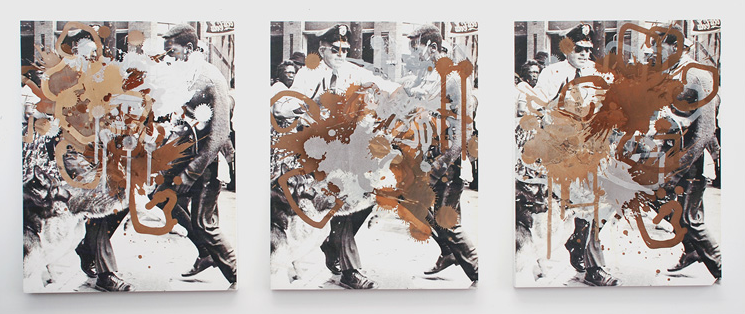
Kelley Walker, Black Star Press; Star, Star, Star Press, 2007. Digital print with silkscreened white, milk, and dark chocolate on canvas mounted to wood panel. 36 x 84 inches.
A controversy continues to rage at the Contemporary Art Museum, St. Louis, Missouri, (CAMSTL) around the exhibition Direct Drive by the Georgia-born artist Kelley Walker who appropriates images of African-American history in some of his works.
NCAC reached out to Director Lisa Melandri to offer our support in responding to the controversy, and to point her and museum colleagues to the Museum Best Practices resource. We encouraged the museum to keep the work up despite the controversy around it, and to keep the conversation going and channels for communication open through workshops and programs that address the issues with members of the community.
The exhibition at the CAMSTL is Walker’s first solo exhibition at a US museum. The works in question, which Walker produced a decade ago, have drawn the ire of activists and artists from the St. Louis African American community and museum staffers, who find the works to be racially insensitive and demeaning to African Americans, and who have demanded they be removed and the exhibition curator resign. Titled the Black Star Press and the Schema series, they feature photographs of African American women appropriated from covers of KING hip-hop magazine and images of police violence from the 1963 Birmingham civil rights campaign.
Enlarged and printed on canvas, the images are partially obscured by smeared substances including melted chocolate, and toothpaste. The museum website describes Black Star Press as “manipulations [that] mask and partially censor the act of police brutality with a perishable material as well as alter the power dynamic between the image’s subjects.”
In a city where people continue to negotiate the aftermath of the shooting of Michael Brown and the Ferguson riots, some artists and activists in the St. Louis community feel the exhibition points to a disconnect between the museum’s programming and the community it serves.
The outcry brewed after a museum talk in which community members came away upset because of what they felt were evasive and insulting responses to their questions about the artist’s intentions. Following the talk, Walker issued an apology to the CAMSTL community. Both Walker and Uslip are white.
Rather than pull the works, the museum chose another route, starting with a panel discussion, held on Sept 22, with community leaders and artists. To follow up, a second discussion is scheduled October 7. The museum has also temporarily built a walled-off enclosure, accompanied by a sign warning that the cordoned-off works might be “difficult for some viewers.”
IDK Trina seems like an innocent name until you see this. #kelleywalker #camstl #hiphopculture
A photo posted by Dawn Crawford (@dawnacrawford) on
In a statement, the CAMSTL defended its decision to leave Walker’s controversial works on view:
“Taking down the show would violate the museum’s core principles and end the productive dialogue that this work has initiated. CAM has a history of showing controversial artists; we have shown works that have challenged common sensibilities and presented work that has critiqued, in a difficult way, misogyny, patriarchy, homophobia and the military industrial complex, among other issues. Despite the debates and discomfort these exhibitions generated, we never removed them.”
Despite the need for museums and cultural institutions to work with, and not against the communities they serve, they must guard against setting precedents that would jeopardize their capacity to show controversial works in the future. In NCAC’s experience, when there is public outcry and a call to remove artworks that are held to be objectionable, giving in always makes matters worse. Consider when the National Portrait Gallery caved under Republican pressure to remove “A Fire In My Belly,” a video by David Wojnarowicz that includes a clip of ants crawling over a crucifix, from its 2010 Hide/Seek exhibition. In that instance, the demands and threats came not from artists and community activists, but from homophobic GOP lawmakers; that decision has now set the precendent for future controversies.
Art often provokes impassioned responses, and artworks in the exhibition may offend and anger many, but the way to respond is by making dialogue possible: by holding events and offering programs where members of the community can be heard. Removing the artworks from view serves no one: it arrests a necessary conversation, it shifts attention from the issues being discussed (racism and violence) to censorship.
So far, CAMSTL has risen to this difficult challenge.

